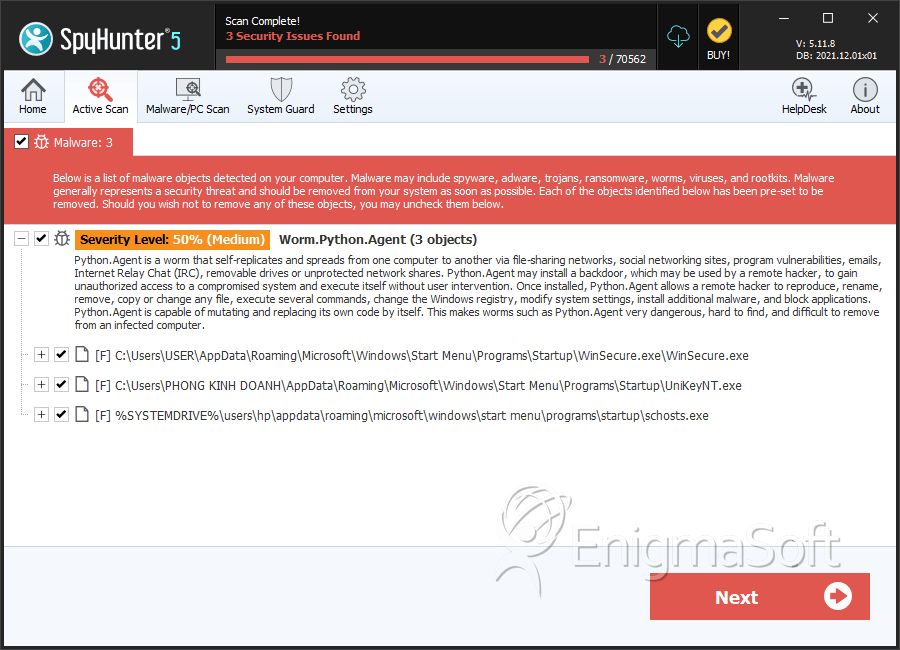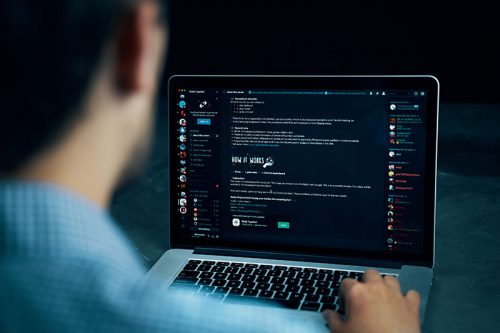Worm.Python.Agent
Threat Scorecard
EnigmaSoft Threat Scorecard
EnigmaSoft Threat Scorecards are assessment reports for different malware threats which have been collected and analyzed by our research team. EnigmaSoft Threat Scorecards evaluate and rank threats using several metrics including real-world and potential risk factors, trends, frequency, prevalence, and persistence. EnigmaSoft Threat Scorecards are updated regularly based on our research data and metrics and are useful for a wide range of computer users, from end users seeking solutions to remove malware from their systems to security experts analyzing threats.
EnigmaSoft Threat Scorecards display a variety of useful information, including:
Ranking: The ranking of a particular threat in EnigmaSoft’s Threat Database.
Severity Level: The determined severity level of an object, represented numerically, based on our risk modeling process and research, as explained in our Threat Assessment Criteria.
Infected Computers: The number of confirmed and suspected cases of a particular threat detected on infected computers as reported by SpyHunter.
See also Threat Assessment Criteria.
| Ranking: | 3,483 |
| Threat Level: | 50 % (Medium) |
| Infected Computers: | 13,194 |
| First Seen: | July 15, 2017 |
| Last Seen: | April 10, 2024 |
| OS(es) Affected: | Windows |
Anti-virus products do not always check for the presence of particular cyber threats – sometimes, they look for a particular behavior that is related to malicious software, and use generic descriptions for such files. One of these descriptions is 'Worm.Python.Agent' – it is typically used to refer to a malicious file that exhibits behavior typical for computer worms. This means that it might be able to self-replicate to removable storage, shared network drives, and other accessible storage. As the name of the detection suggests, the threat is likely to be written in the Python programming language.
Although Worm.Python.Agent is used to describe computer worms, you should know that these threats might exhibit additional harmful traits – often, backdoor Trojans have the ability to spread across the network like a computer worm.
Currently, cybercriminals are abusing the chaos surrounding the Coronavirus outbreak to distribute malicious files that are disguised as leaflets or documents regarding the infamous virus. In many cases, these files might be caught as 'Worm.Python.Agent' by your anti-virus software.
Table of Contents
SpyHunter Detects & Remove Worm.Python.Agent

File System Details
| # | File Name | MD5 |
Detections
Detections: The number of confirmed and suspected cases of a particular threat detected on
infected computers as reported by SpyHunter.
|
|---|---|---|---|
| 1. | f01e5.exe | 3217beecdd50219e106b039a4eb1f662 | 10 |
| 2. | tmp566A.tmpg r.exe | 4f972d5956b43955b9a0b7f215da76d6 | 6 |
| 3. | Hhzge.exe | 8cc695aede6f46df88287895f79a639f | 5 |
| 4. | bot.exe | 69bc8cc4a9e4e9e16674f13bf208fd0a | 4 |
| 5. | Synapse Cracker.exe | e6669644bd9ea8c3acdf7a429b0dfa00 | 4 |
| 6. | DuckySploit.exe | 0af7af82500defa27a94d10d26fe226f | 3 |
| 7. | Nitro Gen +Checker.exe | 3862cfed4cf0c1dcfff667101dd17490 | 3 |
| 8. | ff196.exe | 4a5f3ba4130ab892c1fc4e724e5dbeef | 3 |
| 9. | 2eff39848b503cef5851c596a5ec669b68f1c1115063b8749fe11090c5e028e3.dll | 7112a1006b204998a3587a4677c4478c | 2 |
| 10. | 165776db86405be546ddca54fd8f61fd0b32835338f21450c59fb3bbfdb824dc.dll | 0db6e0b4907f484211d54bb3456a190d | 0 |
| 11. | 1b10af44b46e160c29f5df9d18e20f4c652418c35df8dd8ddd44cb5fe266f5db.dll | 2fa56b2ab4b789bef2916b0992e7a182 | 0 |
| 12. | 209b3ddf6e54adc9166caeb01cdd4de55f125a9a74013db282521a790e113832.dll | 1227d12c93bc6ddcb7cda61d30a6b0fc | 0 |
| 13. | 27eb2c8077ca04969145e1ac6009b43c9d7e8a985a6d6396cf995c33ca46b4b4.dll | 18f00346487206e762ac1886a2821943 | 0 |
| 14. | 2c304604086bf262c0a347be06b29c79d3473994d19ba7b93fd4b1ff464c4b41.dll | 20ed801f031508360ca4a82144d6ca37 | 0 |
| 15. | 2c62b07467f44b41d4cc5d262f6ed5023865be49d5fc6397fff18ab989625cc8.dll | 74fb74e601141fb26f8237b08eaf3436 | 0 |
| 16. | 2ce25ce9423854ee62434c7d1c39c447b8275697a52a333d7faf7d29eaf7694f.dll | d048f0539a6533aaad45ba65e2c570e0 | 0 |
| 17. | 2cf52f36e7955d6b91582886a0f3f57e6866fd9639156b3529fb7cf95833bdf8.dll | c23e48b9a1852c6b059939c68e46f80b | 0 |
| 18. | 2d66e6a62436980e9ca1c20a3328bd9443bff30c1973741b5fc2c405fd88610a.dll | d9f290f4e89190b22ea6acc518278705 | 0 |
| 19. | 2e648818d565bbb6c7d75c8422e0585474ef8935e8a96d729d86c1185f626acf.dll | 0dec91b7e1903084cd03994ac60379a4 | 0 |
| 20. | 3037284254db7c7625c55e62b3cf1756d61ef13252d39328a85ef3328f92c7fb.dll | e51647456693b5de9d6e79ebf242153a | 0 |
| 21. | f3629aa4e8cab2a37f5f091713433497b932c1b905ce5ee1612119a16fb2eaa0.dll | 017eda0818fb8bf4d00eb7130ade6d93 | 0 |
| 22. | f6d399d120fa9538cb5c92cb7640fd02e1f75ef23ecc9f7b4dc7c0f4eee1bf87.dll | c40e9ccad5f955141a9b8c916016b25a | 0 |
| 23. | f8ef973955f80c7534411aa3e2e139309417b194ab8826aa2538a3d5440c1ed4.dll | 22aa654d4df4ea3511bf26d1c4206177 | 0 |
| 24. | fbbe95e4c7506970977d4f512a3d14a6898fb817ccab72fe6151ff6367ef6be6.dll | 1f04130f006cfb928199e809c16d9fcf | 0 |
| 25. | fc9e14183f423833e422e8a0afc9563a06e62141f4cbaa4bbad63f7556c9eb52.dll | 660e2aee8f90843f6fb3751d12fe6211 | 0 |
| 26. | fdac22b28a1a3ff6cdbbc03621fbdfbd26c96dae2d8da1a5155a52a4b970bc63.dll | 285ea02854174e0373eb21710f9fa631 | 0 |

Submit Comment
Please DO NOT use this comment system for support or billing questions. For SpyHunter technical support requests, please contact our technical support team directly by opening a customer support ticket via your SpyHunter. For billing issues, please refer to our "Billing Questions or Problems?" page. For general inquiries (complaints, legal, press, marketing, copyright), visit our "Inquiries and Feedback" page.